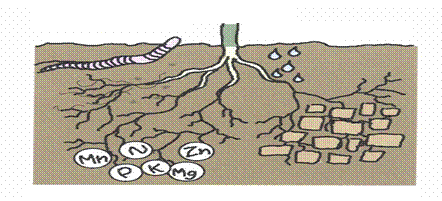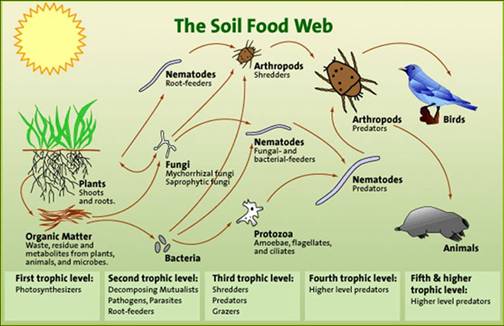Soil is the earth’s foundation for all land-based living organisms including - not only ourselves - but also the crops grown by farmers to generate an income. In order to feed ourselves we need to be able to feed the soil with organic matter - humus.
Biological soil
Healthy Soil = Healthy Plants = Healthy Animals = Healthy Population
The biological life of the soil is often overlooked and soil is often viewed only in physical or chemical terms. In truth, the biological component of the soil is most important as it delivers some of the soils main functions, including:
- Soil formation and aggregation.
- Organic matter breakdown.
- Degradation of toxic substances.
- Transformation of inorganic substances.
- Beneficial association with plants.
- Development and prevention of plant disease.
Importance of soil biology
Healthy soil contains extremely large numbers of living micro-organisms generally, 600 million bacteria per gram (about one teaspoon). Typical farming soil can contain 100 million bacteria per gram while desert soil, with little structure and fertility, only contains around 1 million bacteria per gram.
The rhizosphere, the thin layer of soil immediately next to a plant root, typically has 1 million bacteria per gram.
Diversity of bacteria is important. In 1 gram of healthy soil there can be 15,000-20,000 different species of bacteria with approximately 10,000 in typical farming soil and 5,000-8,000 in desert soil.
Fungi are also very important, especially mycorrhiza which form close associations with plant roots. Fungi greatly exceed the volume of bacteria in soil, up to 1km of fungal hyphae has been measured in 1 gram of soil. The mychorriza fungi transfer water and nutrients directly from the soil into plant roots.
Feeding the soil It is important to recognise that no two farms are the same - they are nearly always located in different landscapes with varying micro and macro-climates. However, the principles of feeding and maintaining the soil are the same whatever region your farm is located and whichever soil type you have. Compost How do we feed the soil? As vegetables are food for us, compost is food for soil organisms. These soil organisms are an important part of the soil food web. Using good compost provides the following benefits: - Nutrient provision - Greater water retention. - Improved soil structure. - Disease suppression. |
|
- Increased pest tolerance.
- Elevated yields.
While compost production is not a cheap operation it can be justified for high value crops such as vegetables. Producing consistent quality compost requires time and investment. Suitable compost turning equipment ranges from about $11,000 to $300,000. While small-scale composting can be done with a pitch-fork and some sweat to turn the pile.
Rather than purchasing costly organic matter, in some areas it may be possible to develop relationships with local councils who want their green waste removed. Composting can also provide a new and lucrative enterprise on the farm if sold to other farmers.
Crop rotations
Crop rotations are the cornerstone of organic production and are used to prevent the build up of pests and diseases. Part of an organic rotation should include a fertility building phase using legumes such as clover, to increase nitrogen levels in the soil. Aside from building fertility, non-cropped diverse areas are essential for harbouring natural enemies such Ladybirds and Damsel bugs which are vital in pest control. Organic growers should allow up to 25% of their land to be not yielding a financial return at any one time.
Green manures The use of green manure crops in organic farming is clearly advantageous. Clover, when used as a green manure crop provides many benefits to the soil. As well as it excellent nitrogen building properties, clover like other green manures can help recycle other nutrients including, phosphorous (P), potassium (K), calcium (Ca), magnesium (Mg) and sulphur (S). After a green manure crop is incorporated into the soil - and during it’s decomposition - essential plant nutrients slowly become available to following crops. |  |
| A well balanced soil after a green manure crop. |
As with compost, green manures add benefical organic matter to the soil, which in turn breaks down to form humus. During the breakdown of organic matter by micro-organisms, compounds are formed that are resistant to decomposition and help bind soil particles together as aggregates. A well aggregated soil tills easily, is well aerated and absorbs water more easily. All this creates vibrant soil conditions for crop growth.
Vermi-composting
Earthworms are beneficial to the soil for many reasons. They are decomposers, facilitating the breakdown of organic matter in and on top of the soil. Worms actually consume the microbes that are in turn consuming the decaying plant matter. Worm casts (waste) are therefore enhanced with many more microbes, which help speed up the decaying process.
Fully worked vermi-compost has passed through the guts of worms to end up as a biologically active, dark rich and fine soil-like material. It contains numerous beneficial micro-organisms, enzymes, plant stimulants, humus and other nutrients in a form readily available to plants.
Nutrient budgeting
Nutrients are lost from every farming system when produce is sent to market. Inputs are necessary to replace these lost nutrients. The best way to assess which nutrients are needed is to carry out regular soil tests, ideally annually or if not every second year. A soil test will provide a good reference point to measure how your soil is responding to inputs (green manures, compost) and if these inputs are adequate enough to replace the level of nutrients being removed. A nutrient budget is best viewed as a bank balance, the more in the account (soil) the better off you (plants) are. In an ideal world you should aim to consolidate the nutrient cycle of the farm by selling produce locally and using local green waste to make compost.
In summary
The soil’s main functions are all related to its level of biological activity. Organic matter levels are important but without the presence of soil organisms to break down the organic matter into humus, there is little point alone in increasing levels. It is therefore essential to consider the whole soil picture and the important role of soil biology when making management decisions on your farm.
Where to from here?
For further information on how to farm in a way that cares for the environment, including information on composting, earthworms, converting to organics and certification, order your copy of Organic Farming: An Introduction.
Glossary
- Biological: The diversity of life forms in the soil, including plants, animals and micro-organisms.
- Rhizosphere: The thin layer of soil immediately next to the plant root.
- Mychorrhiza: A large group of fungi which form a beneficial relationship with the plant.
- Humus: Partially broken down organic matter.
- Compost: The result of organic materials decomposing in a heap or bin.
- Green Manure: The growing and returning of any crop to the soil.
- Vermi-compost: Material which has passed through the inside of a worm.
 | The author, Alasdair Smithson has extensive practical experience in organic farming and has an honours degree in Organic Agriculture, from Aberystwyth, University of Wales. Alasdair now runs his own certified organic farm and home delivery business, promoting local and seasonal food production in the Byron Bay hinterland. |
References
1. Soil Biological Fertility – Lyn Abbott
2. Soil – The importance and protection of a living soil (Soil Association)
3. Dr Elaine Ingham, Oregon State University, presentation at Soil Association conference, 2001
4. Rothamsted IACR, Annual Report, 2001-2002
5. MAFF and the Royal Society of Chemistry, 1991, “The Composition of Foods”
6. Worthington V, 2001, "Nutritional Quality of Organic Versus Conventional Fruits, Vegetables, and Grains", The Journal of Alternative and Complimentary Medicine, Vol. 7, No. 2, 2001, 161-173.
7. Houghton et al, “Carbon flux to the atmosphere from land-use changes: 1850-1990”
8. Willlison et al, 1995, “Farming, Fertilizers and the Greenhouse Effect”
9. Stolze et al, 1999, "Environmental and resources use impacts of organic farming in Europe”
DEFRA, 1997, "Assessment of relative nitrate losses from organic and conventional farming systems based on recent measurements"




